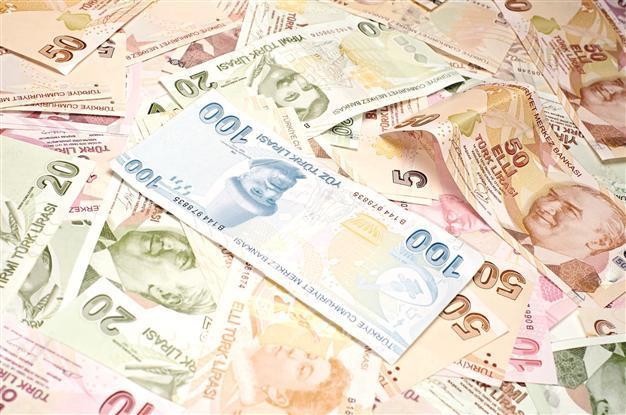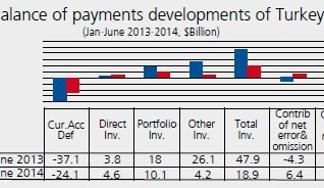Inflow of foreign money down as unregistered capital steps in
MUSTAFA SÖNMEZ - mustafasnmz@hotmail.com

Turkey’s chronic disease, the current account deficit, was $24 billion in the first half of 2014, a 35 percent decline on the figure of $37 billion from the first half of 2013.
It was not particular structural transformations that played a role in this decrease. Because the growth rate is low, the current account deficit also tends to decrease. Investments which are the motor of growth were also low. Thus, foreign exchange expenditures for machinery and equipment have also fallen. With the foreign exchange rate gaining a value of approximately 22 percent in average, with the Turkish Lira losing value, the lira equivalent of the imports bill has increased. This in turn has decreased exports. There are major declines in the imports of automobiles, electronics, cell phones and others.
Even in the import of bar gold which is used as a payment tool for the natural gas imported from Iran, there was a decrease of $6.5 billion alone. As a result, the decrease of all of these foreign currency spending has shrunk the current account deficit.
In summary, if the current account deficit dropped by a third, this is because growth has also fallen off. This year also, especially in the second quarter, growth declined exceptionally and the second half of the year is not full of hope either. It appears unlikely that the growth target of 4 percent will be met.

When the financing of the current account deficit is reviewed, more important things can be seen. It can be drawn from the first six months of the year that the inflowing money has decreased 60 percent and went back from $48 billion to $19 billion. In other words, a foreign capital inflow that has been minus $29 billion has occurred. This is the most remarkable aspect.
Significant drops are observed both in hot money which are called portfolio investments and also in bank loans and inflow of foreign deposits. Out of the total decrease of $29 billion, $8 billion are due to the drop in hot money and the remaining $21 billion have stemmed from the restriction of loans and withdrawal of foreign deposits.
The outflow of foreign money that started with the FED announcement of monetary policy changes in May 2013 has increased particularly with the overflowing of political risk following the launching of the Dec. 17 and 25, 2013, graft operations. For re-entries, foreigners especially waited for the results of March 30 elections; an influx started in the following months but, nevertheless, what entered by the end of June stayed 60 percent behind what came in the first half of 2013.
In this withdrawal, one needs to take into consideration particularly the fall in load demands from Turkey. Banks, when they lowered their consumer credit placements with the rising interest rates especially, when domestic demand shrank and loan demands decreased, a drop was also experienced in the tempo of external loans.
Unregistered entries When the inflowing foreign source was not adequate to meet the current account deficit, the foreign exchange rate could have even hiked more but this time the unregistered capital, the official name of which is “net errors and omissions,” stepped in.
We understand from Central Bank data that in the first half of 2013, a source of $4.3 billion remained unregistered to return to the system as $6.4 billion in the first half of 2014, patching up the deficit. At the end, as well as covering the deficit, also money worth $1.2 billion entered the reserves.
It is remarkable that unregistered capital has reached $6.4 billion in the first half of the year. It remained at $2.5 billion in the entire year of 2013 and in 2012 at $1 billion.
This year, it looks like it will be like 2011. When the current account deficit was breaking records with $75 billion in 2011, the entry of unregistered capital also broke records with $9.1 billion, covering 12 percent of the deficit.
 Current account deficit always a headache
Current account deficit always a headache It should be considered proof of Turkey’s foreign dependency that despite the growth of only 2.5-3 percent, the current account deficit reached $24 billion in the first half of the year. Turkey is not able to break its dependency particularly in energy importing; it supplies up to 70 percent of the input of many products it is exporting through imports and even food imports such as meat, grains and others are added to that.
The hardened imports increase the need for foreign currency, thus resulting in a dependency on the inflow of external money. When the halt of the inflow of foreign money pushes the foreign exchange rate upward domestically, everything starts cracking – the burden of $390 billion of international loans, 40 percent of which needs to be refinanced in 12 months, tenses up all debtor banks, companies and the public budget, causing some sleepless nights.
Sources of net errors and omissions
Net errors and omissions, by definition, are caused by measurement mistakes and the miscalculation or over-calculation of balance of payments data like exports, imports, services and the like. It cannot be known which item in the balance of payments table caused the error or omission, but it can be predicted. The cause of net errors and omissions are usually expected to stem from the private sector.
The reasons for net errors and omissions can be summarized like this:
-The removal of some revenues yielded from some items in the balance of payments outside the system (cash under the mattress, etc.) without being recorded or the use of resources outside of the registered system during financing.
-Foreign exchange entry or payments conducted as part of operations defined within the criminal economy.
-Time inconsistency that arises when an imported or exported good’s movement and its payment are reflected in different balance sheet periods.
-Declaration mistakes during customs procedures.
-Errors stemming from extraction of data (like tourism and suitcase trade figures) through surveys.
 Turkey’s chronic disease, the current account deficit, was $24 billion in the first half of 2014, a 35 percent decline on the figure of $37 billion from the first half of 2013.
Turkey’s chronic disease, the current account deficit, was $24 billion in the first half of 2014, a 35 percent decline on the figure of $37 billion from the first half of 2013.  When the financing of the current account deficit is reviewed, more important things can be seen. It can be drawn from the first six months of the year that the inflowing money has decreased 60 percent and went back from $48 billion to $19 billion. In other words, a foreign capital inflow that has been minus $29 billion has occurred. This is the most remarkable aspect.
When the financing of the current account deficit is reviewed, more important things can be seen. It can be drawn from the first six months of the year that the inflowing money has decreased 60 percent and went back from $48 billion to $19 billion. In other words, a foreign capital inflow that has been minus $29 billion has occurred. This is the most remarkable aspect. Current account deficit always a headache
Current account deficit always a headache